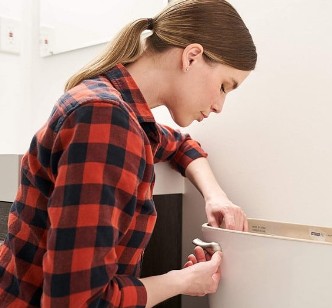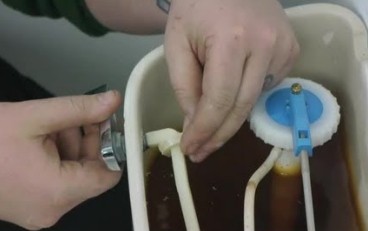Flushing your toilet becomes less efficient and more frustrating if you have to use excess force to push down the toilet handle. You can be assured that you have an issue when pushing the handle gets tricky, but what makes a toilet handle hard to push down?
Many reasons can make a toilet handle hard to push down. These are a faulty flapper, incorrect chain length, corroded handle, malfunctioning flush valve, tight mounting mechanism, and low home water pressure.
The upside is you can fix these issues yourself, but the downside is you’ll have to get your handle dirty since you may need to replace malfunctioning parts.
Below is a walkthrough of the appropriate fixes for the causes of a malfunctioning toilet handle.

Toilet Handle Hard To Push Down (Causes & Fixes)
| Problem | Possible Causes | Recommended Fixes | |
| 1. | Faulty Flapper | Debris buildup The flapper is too big or small Wrong installation Wear and tear | Clean your toilet tank Get the right flapper Reinstall the flapper Replace the damaged flapper |
| 2. | Incorrect Chain Length | Long toilet chain Short toilet chain | Shorten or lengthen the chain |
| 3. | Damaged Handle | Loose handle Worn out handle | Tighten any loose nuts Replace the handle |
| 4. | Malfunctioning Flush Valve | The flush valve is clogged, damaged, or sticking | Clean or replace the flush valve |
| 5. | Low Water Pressure | Malfunctioning supply valve Damaged or clogged supply line Partially opening the shut-off valve | Clean or repair the supply valve Unclog or replace the supply line Fully open the shut-off valve |
| 6. | Tight Mounting Mechanism | Tightening the handle’s mounting mechanism | Readjust the mounting mechanism |
1. Faulty Flapper
Typically, when you push the toilet handle down, it lifts a lever that pulls up the chain attached to the flapper, thus opening the flapper. Once the flapper opens, water flows down, flushing your toilet.
However, a faulty flapper can fail to lift correctly when you push the handle, creating resistance and making the toilet handle difficult to push down. A toilet flapper can malfunction if it gets sticky, is the wrong size, is old or is installed wrongly.
A flapper can get stuck from using excess bleach or dust accumulation inside the tank. On the other hand, the flapper will not form a proper seal if it is too big or too small, allowing some water to pass even if you don’t flush your toilet.
Furthermore, an improper installation can also cause the flapper to malfunction, and so will wear and tear.
Fix
Depending on what’s causing the flapper to malfunction, here’s how to fix it:
- Clean your toilet tank to remove debris, making sure you reach everywhere, including underneath the flapper. Also, avoid using bleach.
- Reinstall the flapper is installed incorrectly. However, before doing so, ensure it is in good condition.
- Buy and install a new flapper if the current one is worn out, too big, or too small.
2. Incorrect Chain Length
The toilet chain connects different flushing mechanisms, including the handle and flapper. For the toilet to flush efficiently, the chain must be the right length and in excellent condition.
Therefore, if the length of your toilet chain is incorrect, it can create tension that makes lifting the flapper difficult, so you must use more energy to push the handle. For instance, if the chain is excessively short, the flapper may be pulled too high, creating tension, thus rendering pushing the flush handle difficult.
On the other hand, an excessively long chain can get tangled or caught on other toilet parts, which can also make it harder to push down the handle.
Fix
You must adjust the chain length by either loosening or tightening it to make it easier to push down the handle. Tweaking the chain length ensures the flapper lifts correctly and the handle is easier to push down.
The correct toilet chain length depends on the toilet’s flushing mechanism. Generally, the chain should be long enough to open the flapper or flush valve fully and allow water to flow into the bowl.
However, it should not be so long that the chain becomes slack and gets caught under the flapper, preventing it from sealing properly and causing water to leak out of the tank continuously.
Here’s how to determine the correct length for your toilet’s chain:
- Detach the lid, then flush your toilet.
- Observe the chain as the flush valve or flapper opens, causing the flow to flow down.
- Adjust the chain length so that it is just long enough to allow the flapper or flush valve to open fully and the water to flow smoothly into the bowl.
You will likely get the right length after adjusting it a few times. Furthermore, consider periodically checking the chain length and adjusting it if necessary because it can sometimes become stretched or tangled over time.

3. Damaged Handle
Your toilet handle initiates the flushing action when you push it down. This component must work appropriately for the lever to lift the flapper, but like other toilet parts, the handle will eventually wear out or come loose.
If the handle is damaged or corroded, it may not be able to lift the lever properly, which can create resistance and make it harder to push down. Moreover, the handle can get bent or cracked, or the handle’s mechanism can break or suffer wear and tear.
Fix
You may be able to fix a damaged toilet handle by adjusting the connections between the handle and the lever. Also, check if the nuts are loose, then tighten them.
However, a severely worn-out or damaged handle must be replaced to restore proper function. Replacing the handle is typically a straightforward process that involves removing the old handle and installing a new one using simple hand tools.
4. Malfunctioning Flush Valve
Like a faulty flapper, a malfunctioning flush valve can fail to fully open when you push the handle creating resistance which in turn makes the handle hard to push. A flush valve can malfunction if clogged, damaged, sticking, or its sealing mechanism has an issue.
Fixing a malfunctioning flush valve is imperative because it can cause other issues besides handle issues, including poor flushing or continuous running.
Fix
- Use a water and vinegar mixture and a soft brush to clean your toilet flush valve.
- Adjust the position of the flush valve by loosening the mounting nut and then moving it in any direction to ensure it’s properly seated.
- Install a quality and compatible replacement flush valve if the current one is damaged or sticking. Tighten and secure the mounting appropriately, then reattach the toilet chain.
5. Low Water Pressure
Low water pressure is unlikely to generate sufficient force to lift your toilet’s flush valve, thus creating resistance and making the flush handle difficult to pull. Water pressure problems can be caused by different issues, such as a malfunctioning supply valve, a clogged or damaged supply line, or even not opening the shut-off valve fully.
Fix
Clean or repair the supply valve, replace damaged or clogged pipes, or raise the water pressure with a pressure booster pump. Moreover, the solution to your issue may be as simple as fully opening the shut-off valve
However, if these solutions do not fix the water pressure issue, hire a plumber.
6. Tight Handle’s Mounting Mechanism
An overtightened flush handle mounting mechanism makes the handle too stiff, making it tedious to push it down. Typically, the mounting mechanism should provide some clearance to facilitate effortless handle movement.
Fix
Loosen the mounting mechanism a bit.

How To Replace A Toilet Handle
You can replace a toilet handle with a few steps and tools. However, before doing so, buy a quality replacement handle like Qualihome Toilet Handle Lever Flush Replacement (Check on Amazon) that offers a universal size, efficient flushing, and is sleek and stylish.
After buying your replacement handle, follow these steps to install it:
- Close the shut-off valve, usually found on the wall behind the toilet.
- Drain as much water by flushing, then remove the lid and set it aside.
- Find the mounting nut securing the toilet handle (you’ll find it inside the toilet tank, directly behind the flush handle).
- Loosen the mounting nut using a wrench or pliers, then take out the old toilet handle.
- Slide the replacement handle’s metal rod through the toilet tank’s hole where the old handle was located.
- Tighten the mounting nut with a wrench or pliers to secure the new handle to your toilet tank. However, do not overtighten since that can damage the tank.
- Attach the chain or lift wire to the flush valve, then restore the water supply.
- Once the tank is full, flush your toilet multiple times to test the new handle.
Final Thoughts On Toilet Handle Hard To Push Down
Restoring the normal functioning of your toilet’s flush handle gets easier once you determine what’s causing pushing it down to be challenging. When troubleshooting, check the issues discussed above, then fix them accordingly.
Here are other related topics:
